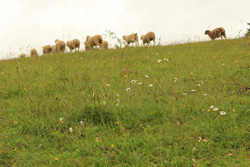Variation in land-use intensity leads to higher biodiversity

Variation in land-use intensity between years – as here in the Schwäbische Alb – leads to higher biodiversity.<br><br>Photo: Ilka Mai, Botanischer Garten der Universität Potsdam<br>
Globally, the intensification of agricultural land use is considered the leading threat to biodiversity. Previous studies on the impacts of land-use intensity on biodiversity have only looked at single or small groups of organisms. However, individual species can vary greatly in how they respond to different land uses, meaning that the overall impact on biodiversity is often not clear.
A research study, published in the Proceedings of the National Academy of Science (PNAS), led by the Professors Eric Allan and Markus Fischer at the University of Bern, shows that farmers can help protect grassland biodiversity by varying management intensity over time. This reduces some of the negative effects of intensive land use, particularly for rare species.
New index measures ecosystem biodiversity
A team of 58 scientists, from both Switzerland and Germany, assembled a uniquely comprehensive dataset on the biodiversity of up to 49 groups of organisms, including groups of bacteria, fungi, plants and animals. They used data from study sites that they had established in 150 grasslands in three regions of Germany, the Biodiversity Exploratories, which varied from extensively managed and lightly grazed to intensively grazed or mown grasslands with high fertilizer input.
The scientists used these data to compile a novel index of «multidiversity», which measures total ecosystem biodiversity. «The study showed that overall biodiversity declined very strongly with increasing land-use intensity and that this was particularly true for rarer species», explains Eric Allan of the Institute of Plant Sciences at the University of Bern. Plants, grasshoppers and butterflies declined most strongly.
According to Eric Allan, the results provide very strong evidence for the importance of extensively managed grasslands for nature conservation: «This new index provides a single measure of biodiversity for an ecosystem and should make it easier to assess the effects of conservation measures or restoration efforts on biodiversity.»
Variation in land-use intensity as new strategy
Interestingly, the scientists also found biodiversity to be much higher in grasslands in which land-use intensity had varied over the last few years. «This suggests that varying management intensity over time could be a novel strategy to maintain biodiversity in grasslands, for instance by altering the number of livestock or the frequency of mowing between years», explains Markus Fischer.
The rare species in the study benefited particularly from changing land use over time: At intermediate land-use intensity, the biodiversity of the rarer species was almost twice as high when land-use intensity varied between years. «This result shows that farmers could do a lot for biodiversity conservation simply by varying the intensity of their land-use between years, as long as the mean intensity of management does not get too high», says Eric Allan.
Publication details:
Allan E, Bossdorf O, Dormann CF, Prati D, Gossner M, Blüthgen N, Barto K, Bellach M, Birkhofer K, Boch S, Böhm S, Börschig C, Chatzinotas A, Christ S, Daniel R, Diekoetter T, Fischer C, Friedl T, Glaser K, Hallman C, Hodaĉ L, Hölzel N, Jung K, Klein AM, Klaus V, Kleinebecker T, Krauss J, Lange M, Müller J, Nacke H, Pašaliæ E, Rillig M, Rothenwöhrer C, Schall P, Scherber C, Schulze W, Socher S, Steckel J, Steffan-Dewenter I, Türke M, Tscharntke T, Weiner C, Werner M, Westphal C, Wolters V, Wubet T, Gockel S, Gorke M, Hemp A, Renner SC, Schöning I, Pfeiffer S, König-Ries B, Buscot F, Linsenmair KE, Schulze ED, Weisser WW, Fischer M: Interannual variation in land-use intensity enhances grassland multidiversity, PNAS, in press, doi: 10.1073/pnas.1312213111.
Media Contact
More Information:
http://www.unibe.chAll latest news from the category: Life Sciences and Chemistry
Articles and reports from the Life Sciences and chemistry area deal with applied and basic research into modern biology, chemistry and human medicine.
Valuable information can be found on a range of life sciences fields including bacteriology, biochemistry, bionics, bioinformatics, biophysics, biotechnology, genetics, geobotany, human biology, marine biology, microbiology, molecular biology, cellular biology, zoology, bioinorganic chemistry, microchemistry and environmental chemistry.
Newest articles

NASA: Mystery of life’s handedness deepens
The mystery of why life uses molecules with specific orientations has deepened with a NASA-funded discovery that RNA — a key molecule thought to have potentially held the instructions for…

What are the effects of historic lithium mining on water quality?
Study reveals low levels of common contaminants but high levels of other elements in waters associated with an abandoned lithium mine. Lithium ore and mining waste from a historic lithium…

Quantum-inspired design boosts efficiency of heat-to-electricity conversion
Rice engineers take unconventional route to improving thermophotovoltaic systems. Researchers at Rice University have found a new way to improve a key element of thermophotovoltaic (TPV) systems, which convert heat…



